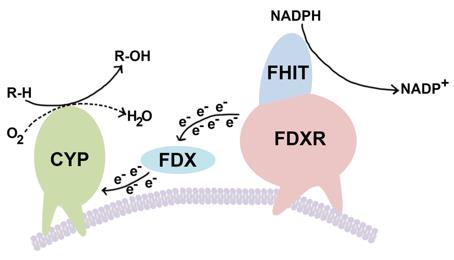What is FDXR Protein
FDXR, or Ferredoxin Reductase, is a key protein involved in electron transfer processes within the cell. Also known by synonyms such as Adrenodoxin Reductase and Adrenodoxin-NADP Reductase, FDXR belongs to the ferredoxin reductase family. This family encompasses a group of proteins responsible for mediating electron transfer reactions, facilitating crucial cellular functions.
FDXR Protein Structural Characteristics and Classification
Structurally, FDXR consists of distinct domains, including the FAD-binding domain, NADP-binding domain, and the iron-sulfur cluster-binding domain. These structural features enable FDXR to interact with various cofactors and substrates, showcasing its versatility in cellular processes.
Recent research has shed light on the dynamic nature of FDXR and its involvement in redox homeostasis. Studies have identified novel regulatory mechanisms governing FDXR expression and activity, providing valuable insights into its functional diversity. Additionally, advancements in structural biology techniques have allowed for a more detailed understanding of the protein's three-dimensional configuration, aiding in the design of targeted interventions.
FDXR Biological Functions and Molecular Mechanisms
The biological functions of FDXR are diverse, reflecting its central role in cellular metabolism. FDXR primarily acts as an electron carrier, shuttling electrons from NADPH to various acceptors, including cytochromes and other redox-active proteins. This electron transfer process is fundamental for the synthesis of essential biomolecules, such as lipids and steroids.
The molecular mechanisms underlying FDXR function involve its interaction with electron donors and acceptors. FDXR receives electrons from NADPH and transfers them to downstream targets, contributing to the maintenance of cellular redox balance. This intricate electron transfer cascade is finely regulated, ensuring the proper functioning of cellular processes that rely on redox reactions.

Figure 1. Mitochondrial cytochrome P450 (cyp) ETC. (Druck T, et al., 2019)
FDXR Related Signaling Pathway
The signal pathway involving FDXR is interconnected with numerous cellular processes. FDXR participates in redox signaling pathways, influencing gene expression and cellular responses to oxidative stress. Elucidating the intricate signaling networks involving FDXR provides valuable insights into its role in health and disease.
FDXR Related Diseases
Aberrations in FDXR expression or activity have been implicated in various diseases. Research has linked FDXR dysregulation to conditions such as cancer, neurodegenerative disorders, and metabolic diseases. Understanding the role of FDXR in disease pathogenesis holds promise for developing targeted therapeutic strategies.
FDXR's Applications in Biomedicine
The unique properties of FDXR make it a promising candidate for applications in biomedical research and development. Its involvement in redox processes positions FDXR as a potential diagnostic marker for conditions characterized by oxidative stress. Furthermore, FDXR holds promise in vaccine development, as its targeted manipulation could enhance immune responses.
- Diagnostics Development
The potential use of FDXR in diagnostics is rooted in its association with oxidative stress-related diseases. Monitoring FDXR levels in biological samples could serve as a biomarker for conditions such as cancer or neurodegenerative disorders, enabling early detection and intervention.
- Vaccine Development
In the realm of vaccine development, FDXR's role in redox processes makes it an intriguing target for enhancing immune responses. Manipulating FDXR expression or activity could potentially augment the efficacy of vaccines, offering new avenues for the development of immunotherapeutic strategies.
- Therapeutics
FDXR's involvement in various diseases positions it as a potential therapeutic target. Strategies aimed at modulating FDXR activity could be explored for conditions where redox imbalance plays a pivotal role, such as certain cancers or neurodegenerative diseases. Targeted therapeutics focusing on FDXR could pave the way for novel treatment approaches.
Recommended Products
| Cat.No. | Product Name | Species | Source (Host) | Tag |
|---|---|---|---|---|
| FDXR-15H | Recombinant Human FDXR protein, His-tagged | Human | E.coli | His |
| FDXR-12836H | Recombinant Human FDXR, GST-tagged | Human | E.coli | GST |
| FDXR-16H | Recombinant Human FDXR protein, MYC/DDK-tagged | Human | HEK293 | Myc/DDK |
| FDXR-12H | Recombinant Human FDXR protein, His/T7-tagged | Human | E.coli | His/T7 |
| FDXR-3406H | Recombinant Human FDXR protein, His-tagged | Human | E.coli | His |
| FDXR-1648H | Recombinant Human FDXR Protein, Myc/DDK-tagged, C13 and N15-labeled | Human | HEK293T | Myc/DDK |
| FDXR-4777HF | Recombinant Full Length Human FDXR Protein, GST-tagged | Human | In Vitro Cell Free System | GST |
| FDXR-4063H | Recombinant Human FDXR Protein, GST-tagged | Human | Wheat Germ | GST |
| FDXR-2898H | Recombinant Human FDXR protein, His-SUMO-tagged | Human | E.coli | His-SUMO |
| Fdxr-2983M | Recombinant Mouse Fdxr Protein, Myc/DDK-tagged | Mouse | HEK293T | Myc/DDK |
Reference
- Druck T, et al. Fhit–Fdxr interaction in the mitochondria: Modulation of reactive oxygen species generation and apoptosis in cancer cells. Cell Death & Disease. 2019, 10(3): 147.

